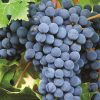The variety had become the wine of the moment in markets like the United States and England, then pushed by the Australians with their sweet, modern reds, a style that was frankly novel. And in our country, the wine industry observed this phenomenon and began copying the style while searching for the key to opening the door for exportations.
The success of the Queen of the Rhone – Syrah is widely grown in south-west France on the banks of the river and in South Australia, and it appeared to be a sure thing and that led many local winer-ies to produce it and dedicate time to its promotion. Callia, is a perfect example. A move that shook the nest of the press and generated a public love, if not for one summer, at least for a few seasons. But the rise of the Aussie Shiraz, as it is known in the wine country of kangaroos, lasted until the global public turned to the next new thing, which turned out to be Pinot Noir, Merlot and later, Malbec.
Thus, in the first decade of the century the demand slackened and with it fell the libido of the Argentine Syrah. With 13 hectares planted, the variety was relegated to a small corner of the market, and now the wine industry would come looking for the candidate to succeed Malbec (or support it, depending on who you ask), Syrah promises to return with a more elegant style, made with grapes from cold, mountain areas.
You know, Syrah is one of the oldest wine strains in the world. Its name comes from the ancient city of Shiraz, located on the silk road in Persia. Hence it is known by two names: Syrah or Shiraz. The grape has been around since ancient times, there are even theorists who claim it was a Syrah that Jesus and his apostles drank at the last supper. Myths aside, the truth is that the grape has its homeland on the northern Rhone. It gives life as a varietal to wine blends, known for its frank ex-pression and somewhat austere palate, which gave it worldwide recognition, until the Australians, showing their desert viticulture, found a style that captivated the emerging markets.
In Argentina the general public knew precisely that style, fat and sweet wines, but which also offers a silky, thin and elegant profile, with a mysterious and even exotic flavour profile. Precisely why this new style decides the market today. And that´s where the biggest surprises appear. When not required to produce big wines, Syrah gives a violet-red hue, with a fruity, spicy aroma, which can provide curious notes of black olives, leather, earth and tobacco. It also has a tendency to be messy and harsh on the palate. Silky and well rounded when mature in the bottle, it is ideal for storage.
Meats, pastas, hard or aged cheeses and cold cuts are its greatest fans. The reinvention of Syrah. How did the stylistic reinvention of Syrah come about? Why can we now expect difference wines from this grape after almost a decade and a half? From the hands of terroirs high up in the moun-tains, Syrah budded into two regions: the Uco Valley in Mendoza and in San Juan the Pedernal, areas where the variety has tripled its surface area in recent years. Tupungato, Altamira, Vista Flo-res, Pedernal: located 1000 m.a.s.l, where the nights are really cold and thermal amplitude may touch 20 degrees, with days that rarely exceed 33 °. A context which allows a style of elegant and exotic Syrah slowly gets old and seduces new fans. What wines to try? So today there are two types of Syrah in the market. The fat and sweet, from warm areas like the central valleys of San Juan and Mendoza East, and the thin and fresh, from colder areas.
Among them, you should make a comparative tasting to find out the Syrah you like the most. The warm climate Syrah´s are ideal to open with simple meals, snacks and even some meats like pork or lamb. This style has also performed well and today gives us the opportunity to drink tasty wines that help cut the hegemony of Malbec. Among these, Tracia, Callia Alta and Paz, Finca Las Moras from San Juan,. But if we speak of warmer climates, the Northwest also has its gifts as in Cafayate and Salta, Don David or in Aguijón de Abeja, made with grapes from Catamarca. In Mendoza, the inexhaustible Finca Flichman Oak is one of the classics together with Novecento, unbeatable in its relation between price and value.
Then there are the challengers, the Syrah’s from colder climates. They are light in colour and offer exotic aromas, with a certain untidiness, and a fresh palate, well rounded with balsamic flavours. In San Juan this style is possible in Pedernal. From here come the fruits that complete the blend of the Gran Syrah from Finca Las Moras which is also made with grapes from the valleys of Tullum and Zonda but clearly defined by the newest of the valleys. Meanwhile in the Uco Valley, Syrah is grabbing the attention more each day. For example, in Tupungato, Finca Sophenia Reserve, with a European flair that justifies finding the few bottles that go on sale each year, while Salentein Numi-na provides a sophisticated palate, refreshing and novel. For his part, Mauricio Lorca’s Opalo made with grapes from Vista Flores without barrel ageing ensures the purest expression of the Valley. As for the very high end, Iscay from Trapiche (with 5% Viognier) is offering a complex and tense style, made with grapes from Los Arboles in Tupungato. Its intense flavour, with a delicate and complex structure is ideal for our modern market.
Source: Vinómanos



